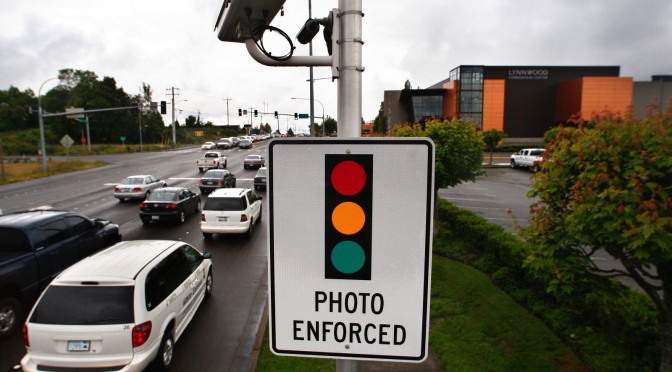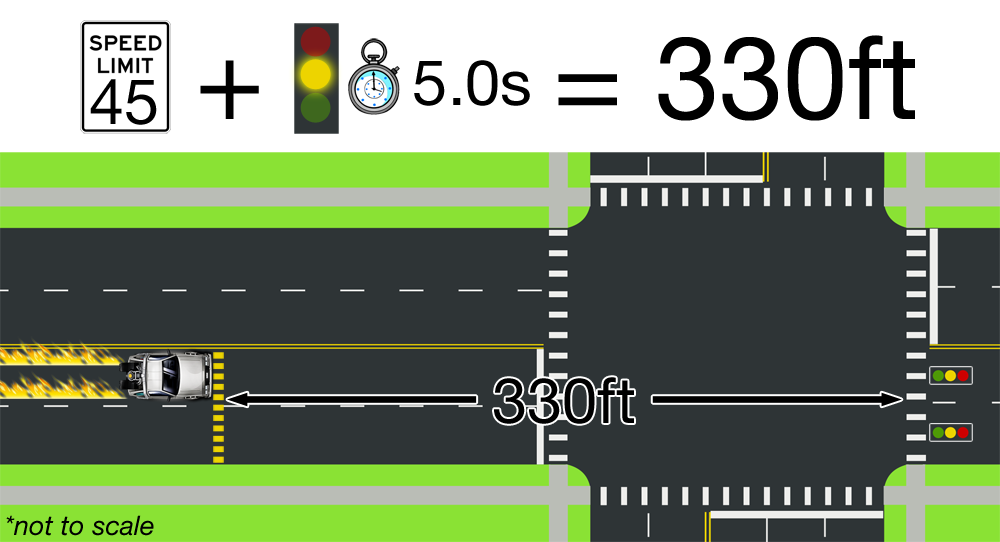
Red light cameras are sold by the companies that install them and the cities that use them as a “safety” feature. Whether or not they actually improve safety is up for debate, but there is no doubt that they are big money makers for the cities that use them. If cities were primarily concerned with safety instead of generating revenue they would get rid of red light cameras and replace them with a yellow light line.
A Yellow Light Line?
tl;dr – Paint a yellow line on the road. If you’re traveling the speed limit as you approach an intersection and you’ve passed the yellow line when the light turns yellow, just keep going and you’ll clear the intersection before the light turns red. If you’re behind the yellow line, hit the brakes because the light will turn red before you clear the intersection.
How it Works
Actually there isn’t much more to it than that. Here’s what a city would need to do to implement yellow light lines:
- use the speed limit and the length time the traffic light stays yellow to calculate distance
- paint the yellow light line on the street at the distance calculated in step 1
- there is no step 3
Simple, effective, and cheap.
Why It’s Needed
Intersections controlled by traffic signals have a basic design flaw that red light cameras only serve to exacerbate. Drivers are unsure of how long they have to clear the intersection once the light turns yellow. Should you slow down or speed up? Every intersection has different timing, and when an intersection is equipped with a red light camera that doles out $124 tickets, drivers are much more likely to slam on the brakes even if they could make it through safely. This leads to more rear-end collisions.
With yellow light lines, that ambiguity is completely eliminated with a simple, clear visual. If you’ve passed the line when the light turns yellow, continue on at the speed limit and you will safely clear the intersection before the light turns red. If the line is in front of you, you’ll need to stop. No more uncertainty, no more slamming on the brakes.
Yellow Light Line Calculator
In order to help visualize this concept I’ve created this handy calculator. Simply edit the speed limit and/or the yellow light length to see how far from the intersection the yellow light line would be painted.
Addressing Objections
This section has been added to address some of the objections brought up by Redditors at /r/Seattle.
It’s not illegal to be in the intersection when the light turns red, it’s illegal to enter the intersection after the light turns red. – davethegr8
Indeed, the relevant law here in Washington State (RCW 46.61.055) indicates that it is only illegal to enter the intersection on a red light. However, since the purpose of the yellow light line is not to adhere to strict legal definitions but rather to improve safety, I think it would be best to measure the distance from the end of the intersection rather than the entrance.
How about telling people what you did so they know what the lines are? – Sir_Dude
This is a good point. Above I jokingly said “there is no step 3,” but in reality step 3 would be driver education.
Oh, and how are these lines going to work with heavier vehicles? An SUV is going to need more room to stop than a Prius. One line isn’t going to work for all cars. – Sir_Dude
The yellow light line is not placed based on how long it will take you to stop. The line is placed based on where you can clear the intersection while traveling at the speed limit.
Example: A driver in a Prius is driving the limit on a 35mph road and the light stays yellow for three seconds. They will travel 154 feet during the three seconds that the light is yellow. A driver in a big rig, will still travel the same 154 feet if they are driving 35mph for three seconds. So we paint the yellow light line 154 feet from the end of the intersection.
If three seconds is not enough time for a big rig to stop, then the length of time the light is yellow should be adjusted by the city. This obviously would move the location of the yellow light line, but the correct location of the line is not variable for different vehicles, it depends only on the speed limit and the length of time the light is yellow.
Currently, judgement is all drivers depend on. If you suddenly give drivers a “tip” for determining if they should go or stop, what will change? People tend to be aware of their current speed, their braking capability based on vehicle characteristics, and how far they have before the stop line. – steve_mcgee
It is true that drivers are (or should be) aware of those things. However, what drivers are often unaware of is how long the light will stay yellow, and whether or not that is enough time to make it through the intersection from their location when it turns yellow. This issue is exacerbated by the fact that different intersections have different yellow light timing. The yellow light line is a simple way of providing exactly that piece of information to drivers.
Light timing changes (gets shorter) on many intersections late at night. The timing would be off on clearing the intersection or you’d need two lines. – eran76
The overall cycle of a given traffic signal may get shorter at night, but the length of time the light is yellow is constant regardless of how long the light stays red or green, and does not change throughout the day.
What’s Next?
Like this idea? Contact your local city council and point them to this post. Share it on your favorite social media site and spread the word. Or if you’re really ambitious, file a statewide citizen’s initiative. If you feel like living dangerously, you can run the calculator for the intersections in your neighborhood, grab some yellow paint, and engage in some “Guerrilla Public Service” like L.A. artist Richard Ankrom, who installed his own freeway sign in 2001.
I’ve also provided a handy embed code above so you can easily share the yellow light line calculator.
Or maybe you think I’m a clueless idiot and this is an incredibly stupid idea? Point out the flaws in my logic in the comments below.
As always, thanks for reading.
Featured photo by Dan Bates, Everett Herald

Steve B
One major problem: insufficient opportunity for graft (to quote a popular online pundit).
One minor problem: may need to add an additional distance in the calculation to accommodate the average length of cars/trucks since technically the entirety of the vehicle needs to be out of the intersection before the red light goes on. I don’t know what that would be? 10 feet or 12 feet?
The Tim
Well technically if “you’ve passed the yellow line” when the light turns yellow then you’ll also have completely cleared the intersection by the time the light turns red. If the yellow line is halfway under your car, I suppose you’re in an in-between state, neither “behind the yellow line” nor past it.
Still though, while it may technically be illegal to have not completely cleared the intersection by the time the light turns red, I don’t think there would really be a safety issue if half of your car is still in the intersection for a fraction of a second when the cross traffic gets a green.
You’re definitely spot-on with the major problem you cite though. It’s not expensive enough nor does it pay anyone, so it’s unlikely most governments would want to implement it.
Greg
Steve’s right. You need to include a bit of graft to incentivize city officials to adopt this.
Alex Francis Burchard
That’s a really neat idea, I look forward to some progressive places implementing it! It would make driving a lot less judgement based, and a lot easier to do.
Ken K
I like the thinking but there is no need for this. Here is the RCW: http://app.leg.wa.gov/rcw/default.aspx?cite=46.61.055
It is perfectly fine to be crossing the entrance to the intersection when the light turns red as long as one enters the intersection when the light is yellow. (See section 3 of above law).
The Tim
The point of this idea is to improve safety, not just to strictly adhere to minimum legal requirements. While it is certainly legal to be barely inside the intersection when the light turns red and continue through during the red light, it would be safest for all drivers to completely clear the intersection by the time the light turns red. The yellow light line gives them drivers information that can help them drive more safely.
Joel
They have something similar in British Columbia that is very effective. There is a sign ahead of intersections (essentially the same place where you propose your line) which says something to the effect of light changing when flashing. If the lights start to flash before you pass then you will not make the light….it’s accurate as well, I’ve tried. The result is that if you see the lights you let off the gas and brake slowly.
Tyler
This is a great idea!
Nick Wood
This is the best idea I’ve heard in a long time. I’m about to go pick up some yellow paint right now.
Dennis
What happens when traffic is moving slower than the speed limit? Seems like in poor weather condition or areas/times when traffic moves more slowly that the yellow lines could risk indicating to a driver that they have more time than they actually do.
Mike F.
In Washington it is not illegal to deliberately drive through a yellow light. A yellow light means only that traffic facing the light is “warned” that a red light will soon follow. As long as your vehicle entered the intersection or passed the crosswalk or limit line before the light turned red, you haven’t broken the law. Driving Laws
Jonathan Miller
When I am driving I always have identified this line in my mind. I call it the “point of no return”. While the light is still green, once I cross that line in my mind, I know that I will continue on even if the light turns yellow. Therefore I have already decided what to do before the light turns yellow. Still the line would help.
Jon Lorber
I found this because I had the same idea. It’s really great but the one problem I came up with – what happens when someone is driving under the speed limit because of traffic or weather?
I’m also trying to figure out the thought process that goes through the mind when your at the line when it changes. You will need a split second to think about it.